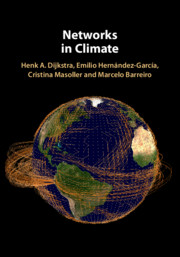Book contents
- Frontmatter
- Contents
- Preface
- Acknowledgements
- 1 The Climate System
- 2 Climate Variability
- 3 Climate Data Analysis
- 4 Climate Networks: Construction Methods and Analysis
- 5 Computational Tools for Network Analysis
- 6 Applications to Atmospheric Variability
- 7 Applications to Oceanic Variability
- 8 Climate Tipping Behavior
- 9 Network-Based Prediction
- References
- Copyright Acknowledgments
- Index
- Plate Section
- References
References
Published online by Cambridge University Press: 15 February 2019
- Frontmatter
- Contents
- Preface
- Acknowledgements
- 1 The Climate System
- 2 Climate Variability
- 3 Climate Data Analysis
- 4 Climate Networks: Construction Methods and Analysis
- 5 Computational Tools for Network Analysis
- 6 Applications to Atmospheric Variability
- 7 Applications to Oceanic Variability
- 8 Climate Tipping Behavior
- 9 Network-Based Prediction
- References
- Copyright Acknowledgments
- Index
- Plate Section
- References
- Type
- Chapter
- Information
- Networks in Climate , pp. 216 - 236Publisher: Cambridge University PressPrint publication year: 2019



